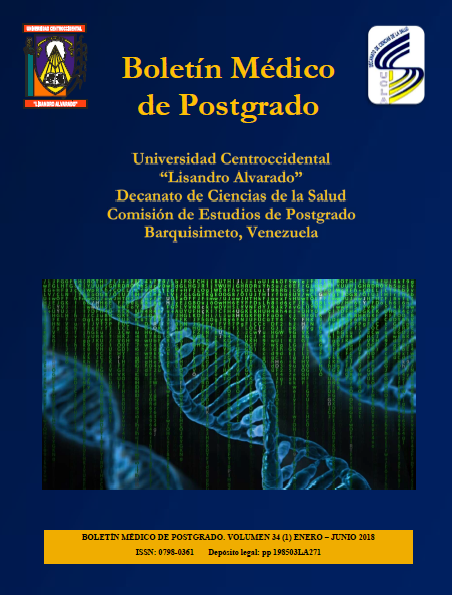Usefulness of the Flint index as a predictor of postoperative complications in colon trauma. Hospital Central Universitario Dr. Antonio María Pineda
Keywords:
colon trauma, Flint index, postoperatory complicationsAbstract
In order to determine the usefulness of the Flint Index as a predictor of postoperative complications in colon trauma in patients admitted to the Servicio de Cirugía General of the Hospital Universitario Dr. Antonio María Pineda, we conducted a cross-sectional descriptive study with 77 patients with an average age of 28.2 ± 10.8 years and predominance of male sex (98.7%). The most frequent mechanism of trauma was by single shot firearm (67.5%); the most affected segment was sigmoid colon (32.4%) and transverse (31.1%); 74% of patients had only one lesion in colon and the most common associated lesions were localized in small intestine (59.7%), liver (19.4%) and kidney (12.9%). According to the severity of trauma, perforation was found in 54.5% of cases, moderate contamination (42.8%), presence of associated lesions (85.7%), discrete hemodynamic situation (59.7%) and delay in treatment of less than 6 hours (45.4%). According to the Flint index, 51.9% of patients had a severity grade III, 40.2% grade II and 7.7% grade I. The treatment was surgical in 88.3% of cases and the most used surgical technique was primary raffia (55.8%), followed by resection/anastomosis (27.9%) and resection/colostomy (25%). In conclusion, the Flint scale is a predictive tool for postoperative complications in patients with colonic trauma.
Downloads
References
2. Pinilla Rafael, Morales Jorge, Gutiérrez Francisco. Sutura primaria en lesiones traumáticas de colon y recto. Rev Cubana Cir 2016; 55(2).
3. Silvera P, Jacinto M. Anastomosis Primaria de Colon en Trauma Abdominal Abierto [Tesis]. Maracaibo: Universidad del Zulia; 2012. Disponible en: http://tesis.luz.edu.ve/tde_busca/arquivo.php?codArquivo=5740.
4. Barciona C. Reparación Primaria Versus Colostomía por Trauma de Colon en el Área de Emergencias del Hospital Luís Vernaza desde enero de 2011 a enero de 2013 [Tesis Previa a la obtención del Título de: Especialista En Cirugía General]. Universidad Católica de Santiago de Guayaquil; 2014.
5. Butt M, Zacharias N, Velmahos G. Penetrating abdominal injuries: management controversies. Scand J Trauma Resusc Emerg Med 2009; 17:19.
6. Wayne M, Rivadeneira D, Scott R. Historical and current trends in colon trauma. Clin Colon Rectal Surg 2012; 25(4): 189-199.
7. Sardinas C, Hernández A, Grass B, Arbona F. Trauma colorrectal y su relación con los índices predictivos. Rev Cubana Med Milit 2002; 31(3):157-63.
Published
How to Cite
Issue
Section
Las opiniones expresadas por los autores no necesariamente reflejan la postura del editor de la publicación ni de la UCLA. Se autoriza la reproducción total o parcial de los textos aquí publicados, siempre y cuando se cite la fuente completa y la dirección electrónica de esta revista. Los autores(as) tienen el derecho de utilizar sus artículos para cualquier propósito siempre y cuando se realice sin fines de lucro. Los autores(as) pueden publicar en internet o cualquier otro medio la versión final aprobada de su trabajo, luego que esta ha sido publicada en esta revista.



